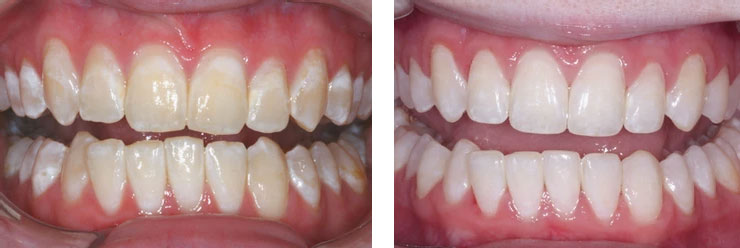What are Tooth Coloured Fillings?
Tooth Coloured Fillings, or composite resins, are used to replace missing tooth structure – to treat decay, replace old defective fillings or restore chipped and worn teeth. The material is a mixture of resin (plastic) and small glass particles (silica), which can be shaped by hand before it is cured with blue light. It is then shaped and polished so it conforms to the desired tooth shape to fully restore the lost tooth structure.
What are the advantages of Tooth Coloured Fillings?
The advantage of using Tooth-coloured fillings are that they closely mimic natural tooth structure to restore function without compromising the strength of your teeth or the quality of your smile and have excellent aesthetics. They are superior to traditional metal fillings which can tarnish and darken tooth structure overtime and very commonly crack and break, requiring much more extensive treatment.
What are the disadvantages of traditional Tooth Coloured Fillings?
There are two major problems with traditional Tooth Coloured Fillings, which is associated to the fact that all composite resins shrink when they set. The first problem is that the traditional approach to placing Tooth Coloured Fillings can create massive shrinkage and significant stress on the tooth as a result. This can cause the tooth to fracture which only compounds the problem. The other major problem with shrinkage of composite resins is that this can create microscopic gaps between the filling and the tooth. Bacteria can easily find their way into these gaps which facilitates further decay and requires replacement of the filling. If the filling is replaced in this traditional technique then the same problem can recur and the cycle repeats itself resulting in further destruction of tooth structure.

So what’s the solution?
By using the leading composite resin and bonding technology, it is possible to completely seal tooth structure with an air-tight/water-tight seal and a minimal and harmless amount of shrinkage. For this to occur, a specific technique must be used. It’s called a multi-layered, multi-coloured, bonded composite resin technique. However, this technique is rarely performed as it requires precision, patience, time to complete and requires a high skill level. The end result though, significantly reduces stress on the tooth, produces a superb aesthetic result and is very long lasting.
What does the treatment procedure involve?
With modern technology, some things can be done comfortably with no local anaesthetic required. Depending on your situation, the appointment may begin with local anaesthetic which is administered comfortably and painlessly with our unique technique. This ensures that the teeth to be worked on are totally, peacefully asleep with no sensitivity. Most of the time, we use the rubber dam (a very thin, rubber shield) to isolate some of the teeth in the area. It acts like a ‘rain coat’ to keep everything out of your mouth – no water, no sucker, no powdered filling material – no mess. The inability to relax is the only thing that can make you uncomfortable, so we coach you on the best way to relax. The decay or defective dental work is removed and the tooth surfaces are sandblasted spotlessly clean, a very important first step in bonding process to achieve an ‘air-tight, water-tight seal. The best bonding agent is applied to seal the tooth and composite resin is placed in multiple steps and light-cured (set) with different light intensities, to minimise shrinkage and stress on the tooth. Finally the resin surface is contoured, shaped and polished to a smooth finish which mimics an natural tooth.
What are the limitations of Tooth Coloured Fillings?
Composite resins, like other filling materials, are not suitable to restore very large cavities. When there is significant loss of tooth structure, a crown offers better function and protection of the remaining tooth structure. However, composite resins can be an interim solution, until a crown can be placed. If the delay is not too long, the material can be left in the tooth when the crown is done.
How long do Tooth Coloured Fillings last?
Composite resins restorations are very technique sensitive. However, if done with the technique outlined, they can have a very successful, long-term outcome with no finite lifespan, if the teeth are looked after appropriately. Longevity is compromised by 2 main factors – lack of proper tooth cleaning (resulting in decay of the tooth) and tooth grinding during sleep (which can break teeth). We encourage regular check-ups and hygiene sessions to pick up any problems before they become serious and we teach you the proper cleaning techniques necessary to achieve low maintenance teeth. Normal chewing is not normally a problem, however, if any significant tooth grinding is present, your teeth must be protected during sleep or the longevity of your dentition in general is compromised and they require greater maintenance as you get older.
What are Preventative Resin Restorations?
A preventative resin restoration is a type of Tooth Coloured Filling, or composite resin, that is used to treat and prevent more decay in the fissures and grooves on the biting surface of molar teeth. Genetically, some people have teeth with have deep fissures that retain plaque bacteria. When this bacteria can’t be cleaned away this results in decay. Preventive Resin Restorations are a minimalist, non-invasive way of cleaning out the deep fissures by removing only the decay and the unhealthy tooth structure. The bonded composite resin is then placed as described above. The result is a more cleanable tooth surface. This is commonly used in kids or young adults, preferably soon after back teeth erupt and before too much decay sets in. It’s then a simple and very safe procedure that often requires no local anaesthetic.
Fissure Seals vs Preventative Resin Restorations
Fissure sealing is the traditional method of preventing decay in the grooves on the biting surfaces of molar teeth. There is no removal of decay and a flowable resin is placed over the decay in the fissures and set. We stopped doing them here many years ago, because the failure rate is very high (about 90% failure at 5 years). However, the failure rate for properly done Preventive Resin Resin Restorations is not zero, but it’s very low.





